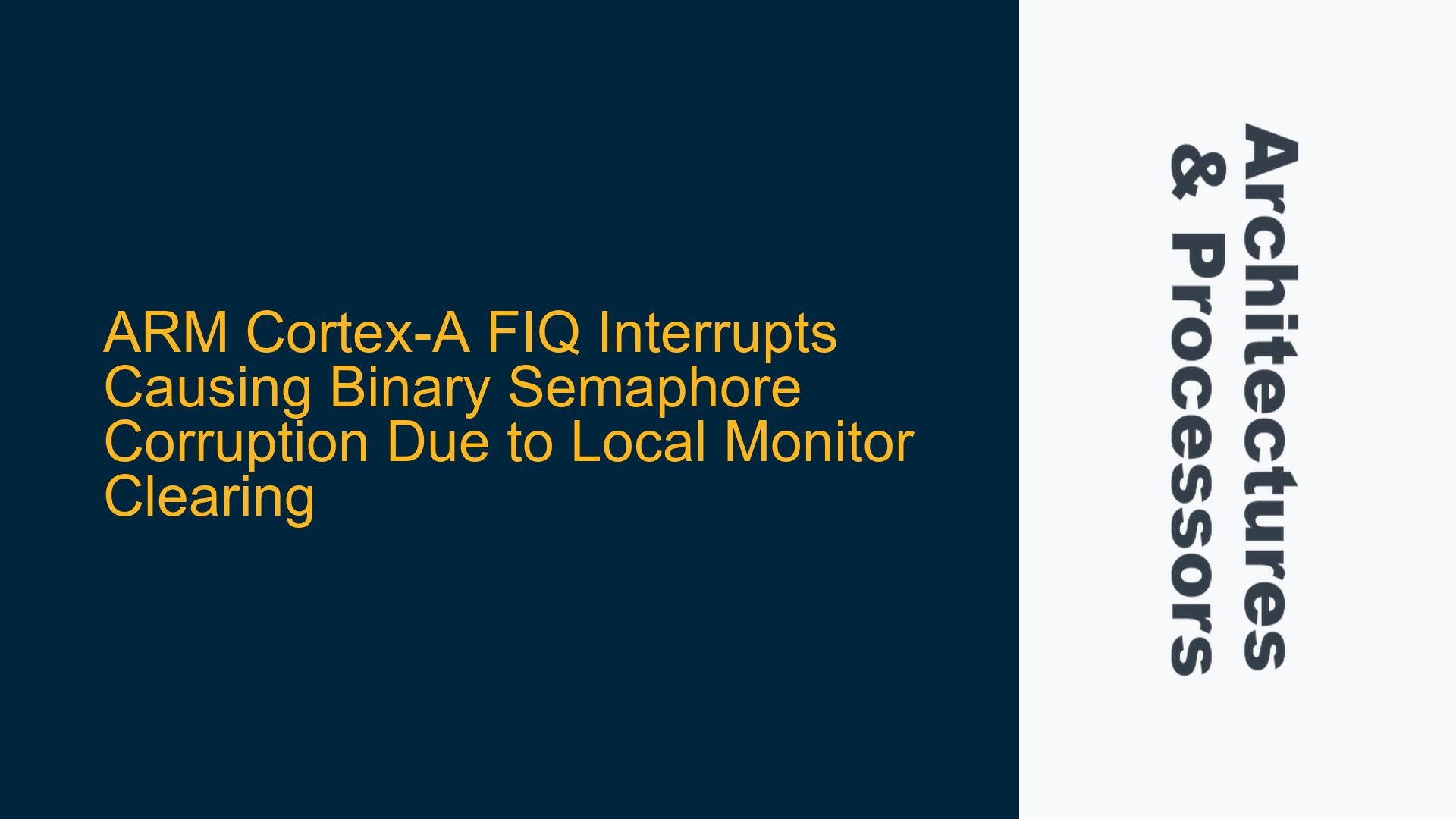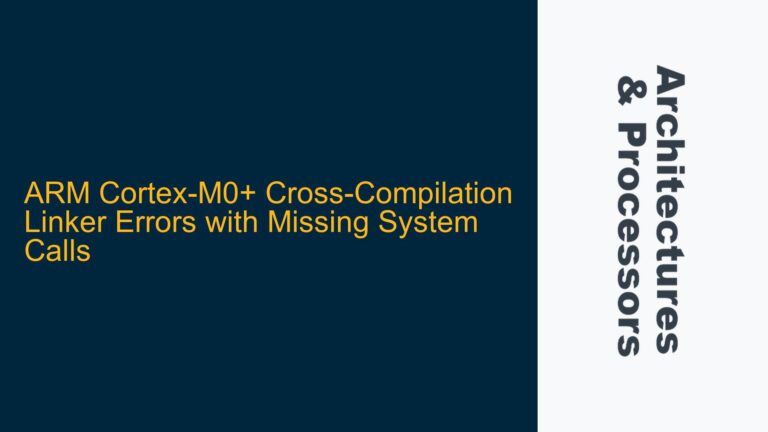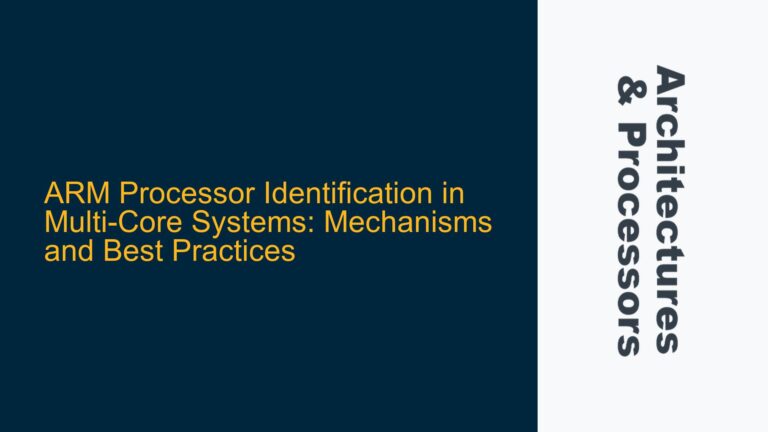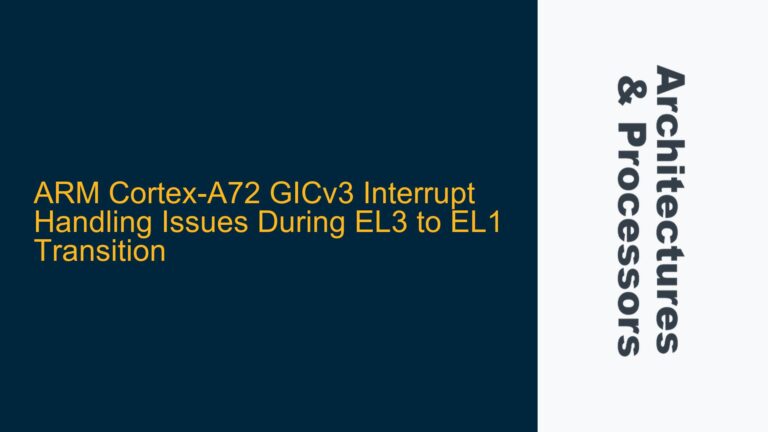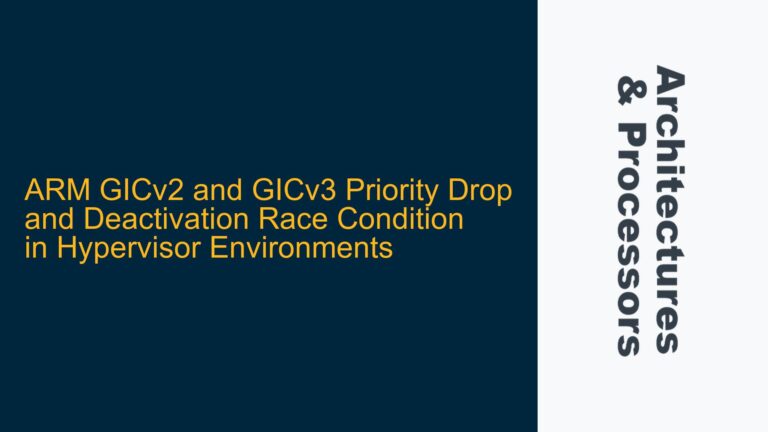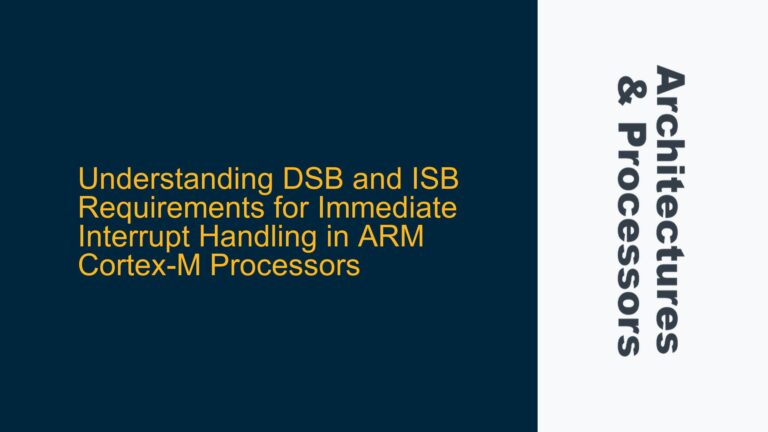ARM Cortex-A FIQ Interrupts and Local Monitor Clearing During Semaphore Operations
The ARM Cortex-A architecture, particularly when dealing with Fast Interrupt Requests (FIQ), can exhibit subtle but critical issues related to the local monitor’s behavior during semaphore operations. The local monitor is a hardware mechanism used to manage exclusive access to memory locations, ensuring atomicity in multi-core or multi-threaded environments. When a FIQ occurs, the local monitor is cleared upon exception return, which can lead to unexpected behavior in semaphore implementations that rely on the Load-Exclusive (LDREX) and Store-Exclusive (STREX) instructions. This issue manifests as semaphore corruption, where critical sections are breached, even though the FIQ handler does not directly interact with the semaphore.
The local monitor is responsible for tracking exclusive access to memory locations. When a core executes an LDREX instruction, it sets the local monitor to track the memory location. If the same core subsequently executes an STREX instruction, the store will only succeed if the local monitor still holds the exclusive access state. However, when a FIQ occurs, the local monitor is cleared upon returning from the exception handler. This clearing of the local monitor can cause the STREX instruction to fail, even if no other core or thread has accessed the memory location. This behavior is documented in the ARM Architecture Reference Manual (ARMv8-A), specifically in section B2.9.4, which discusses context switch support and the impact of exceptions on the local monitor.
The problem becomes particularly pronounced in multi-core systems where semaphores are used to synchronize access to shared resources. If a FIQ occurs between the LDREX and STREX instructions on one core, the local monitor is cleared, and the STREX instruction will fail. This failure can lead to a situation where another core can acquire the semaphore, even though the first core had successfully executed the LDREX instruction. This scenario results in semaphore leakage, where critical sections are breached, leading to potential race conditions and data corruption.
Memory Barrier Omission and Cache Invalidation Timing in FIQ Handlers
One of the key factors contributing to the semaphore corruption issue is the timing of memory barriers and cache invalidation in FIQ handlers. Memory barriers, such as the Data Memory Barrier (DMB) instruction, are used to ensure that memory operations are observed in the correct order by all cores. In the context of semaphore operations, memory barriers are crucial to ensure that the LDREX and STREX instructions are executed in the correct sequence and that the local monitor’s state is consistent across all cores.
However, when a FIQ occurs, the local monitor is cleared upon exception return, and the memory barriers that were in place before the FIQ may no longer be effective. This can lead to a situation where the STREX instruction fails, even though the LDREX instruction had successfully set the local monitor. The failure of the STREX instruction can be attributed to the fact that the local monitor was cleared by the FIQ, and the memory barriers that were in place before the FIQ are no longer sufficient to ensure the correct ordering of memory operations.
In addition to memory barriers, cache invalidation timing can also play a role in the semaphore corruption issue. When a FIQ occurs, the cache may be invalidated as part of the exception handling process. This cache invalidation can affect the state of the local monitor, particularly if the cache contains data that is being tracked by the local monitor. If the cache is invalidated after the LDREX instruction but before the STREX instruction, the local monitor may be cleared, leading to the failure of the STREX instruction.
To mitigate these issues, it is important to ensure that memory barriers and cache invalidation are properly managed in FIQ handlers. This can be achieved by using the appropriate memory barrier instructions, such as the Data Synchronization Barrier (DSB) and Instruction Synchronization Barrier (ISB), to ensure that memory operations are properly ordered and that the local monitor’s state is consistent across all cores. Additionally, cache invalidation should be carefully timed to avoid clearing the local monitor during critical sections of code.
Implementing Data Synchronization Barriers and Cache Management in FIQ Handlers
To address the issue of semaphore corruption caused by FIQ interrupts, it is essential to implement proper data synchronization barriers and cache management in FIQ handlers. The following steps outline the necessary measures to ensure that the local monitor’s state is preserved and that semaphore operations are executed correctly.
-
Use of CLREX Instruction in FIQ Handlers: The CLREX instruction is used to clear the local monitor, ensuring that any pending exclusive access is abandoned. In the context of FIQ handlers, the CLREX instruction should be executed before returning from the exception handler. This ensures that the local monitor is cleared, and any subsequent STREX instructions will fail, preventing semaphore corruption. The CLREX instruction should be placed immediately before the ERET (Exception Return) instruction in the FIQ handler to ensure that the local monitor is cleared before returning to the interrupted code.
-
Proper Use of Memory Barriers: Memory barriers, such as the DMB and DSB instructions, should be used to ensure that memory operations are properly ordered and that the local monitor’s state is consistent across all cores. In the context of semaphore operations, a DMB instruction should be placed before the LDREX instruction to ensure that all previous memory operations are completed before the exclusive access is attempted. Similarly, a DMB instruction should be placed after the STREX instruction to ensure that the result of the store operation is visible to all cores before proceeding with subsequent instructions.
-
Cache Management: Cache invalidation should be carefully managed to avoid clearing the local monitor during critical sections of code. In the context of FIQ handlers, cache invalidation should be performed before the CLREX instruction to ensure that any cached data that is being tracked by the local monitor is properly invalidated. This can be achieved using the Data Cache Clean and Invalidate by Virtual Address (DC CIVAC) instruction, which cleans and invalidates the cache for a specific memory address.
-
Testing and Validation: It is important to thoroughly test and validate the implementation of data synchronization barriers and cache management in FIQ handlers. This can be achieved by using stress tests that simulate high-frequency FIQ interrupts and race conditions to ensure that the semaphore operations are executed correctly and that critical sections are not breached. Additionally, the use of hardware debugging tools, such as JTAG probes, can help to identify and resolve any issues related to the local monitor’s state and memory barriers.
By implementing these measures, it is possible to mitigate the issue of semaphore corruption caused by FIQ interrupts and ensure that critical sections are properly protected. The use of the CLREX instruction, proper memory barriers, and careful cache management are essential to maintaining the integrity of semaphore operations in multi-core ARM Cortex-A systems.
Summary of Key Points
| Key Point | Description |
|---|---|
| Local Monitor Clearing | The local monitor is cleared upon returning from a FIQ, which can cause STREX to fail and lead to semaphore corruption. |
| Memory Barriers | Proper use of DMB and DSB instructions is crucial to ensure correct ordering of memory operations and consistency of the local monitor’s state. |
| Cache Management | Cache invalidation should be carefully timed to avoid clearing the local monitor during critical sections of code. |
| CLREX Instruction | The CLREX instruction should be used in FIQ handlers to clear the local monitor before returning from the exception. |
| Testing and Validation | Thorough testing and validation are necessary to ensure that semaphore operations are executed correctly and that critical sections are not breached. |
In conclusion, the issue of semaphore corruption caused by FIQ interrupts in ARM Cortex-A systems is a complex problem that requires careful management of the local monitor, memory barriers, and cache. By implementing the measures outlined above, it is possible to ensure that semaphore operations are executed correctly and that critical sections are properly protected, even in the presence of high-frequency FIQ interrupts.
